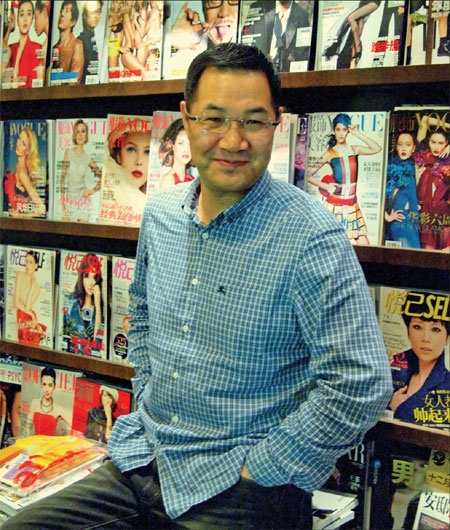A leg up for conde nast
|
 Cao Weiming, managing director of Conde Nast China, says the magazine market will continue to grow because of strong ad sales. [Provided to China Daily]
|
Adapting to the Chinese market and rules has pushed company to the top
Cao Weiming, managing director of Conde Nast China, the publisher of the Chinese edition of Vogue and other lifestyle magazines, says behind the glossy cover of Vogue are years of hard work and perseverance. He says one major hindrance for foreign media companies is a lack of understanding of the local culture, regulations and how things operate in China.
"In emerging markets like China, the magazine market developed very quickly and will continue to be strong with increasing ad sales on the platform of magazine, but it's also a market with risks and challenges," says the 47-year-old.
In China, overseas media groups are required to find a local partner to publish their magazines in the Chinese market. The General Administration of Press and Publication (GAPP), which regulates the media industry. Several Chinese publishers have each worked with several foreign magazines to help them get a Chinese publishing license.
One major aspect that many foreign magazines overlook is, surprisingly, content.
"There is the issue of cultural differences. The same story used in the US version of Vogue may be very inappropriate in China and against common sense here," he says. "But many foreign groups don't understand that. In the end, those with perseverance and better understanding of the local market are squeezed inside, but those without appropriate knowledge were just kicked out of the game."
Throughout most of the '90s, while many foreign fashion magazines in China were testing the market, Conde Nast took its time studying the market with three years of market research and talent recruitment before the launch of Vogue.
When Vogue was launched in 2005 in China, the company invested with their own money instead of finding a third party to operate and take care of the distribution. It worked with China Pictorial, a local publisher in Beijing, to publish the magazine though the local company does not get involved in the operations of Conde Nast.
"We prefer this kind of copyright cooperation because it can guarantee the quality of the magazine and of course comes with higher financial return," he says. "Actually when Vogue hit the Chinese newsstands, it raised the bar for the whole Chinese publishing world because (it) is so well-designed with a clear layout, beautiful photos and nice paper."
In 2011, the Chinese edition of Vogue ranked third among all its international editions in 15 countries in terms of revenue. After its debut of Vogue, the American company also introduced versions of other titles including Self, GQ and Architectural Digest in China. The company has expanded its presence every two years.
Cao says it will take at least five years or more for some of the magazines to generate a profit.
"What Conde Nast is looking at is not only market share but also how to help its Chinese magazines to emerge on the global stage," he says.
But Cao is very confident about the huge growth potential of fashion magazines in China because "the Chinese way of living is changing all the time with their accumulating wealth and strong purchasing power. People are paying more attention to their social lives and getting more and more accustomed to lifestyle of luxury.
"The business of fashion magazines will continue to prosper in China in the coming years even as the publishing industry suffers in the US and Europe amid widespread Internet readership. The driving force is the strong luxury goods consumption which makes lots of international cosmetic and skin care companies become large advertisers for magazines," he says.
According to a report by CTR, a media market research company, ad revenue in the magazine industry jumped 20 percent to $2.37 billion (1.77 billion euros) in 2010.
"But fashion is still a new concept in China and people's knowledge of fashion still lags far behind compared to the readership in the US, France and Italy," Cao says. "In France, people buy five or six fashion magazines every year, but in China, the average consumption may be one or two copies that offers great room for further growth. With more foreign companies tapping into the market, it will become more sophisticated."
Cao, who graduated from Wuhan University with a major in French in 1984 and then went to ESSEC Paris to get his master's degree, had worked for Hachette, the French publishing powerhouse, for 11 years and successfully ran the Chinese versions of Elle, Woman's Day, and Marie Claire.
Cao says working with these foreign media giants gives him a special perspective about how to work in a different cultural background and how to build a mutual trust with these companies so that they can work efficiently in China.
"The two experiences are totally different - French are all about romance and passion. When they do business, they are more like artists looking for creativity and passion, while Americans are more down to the earth. They have clear goals. They know what they want and they pay more attention to teamwork," he says. "If the former is like being in a love relationship, then now working with Conde Nast Group that has a history of more than 100 years feels like a marriage."


















